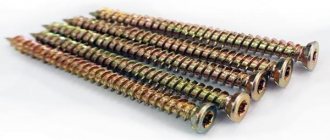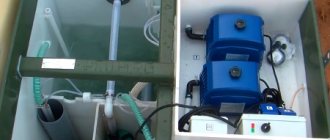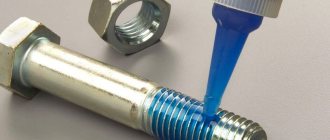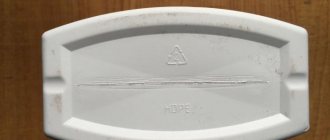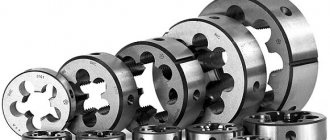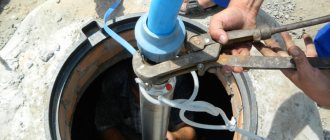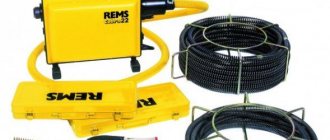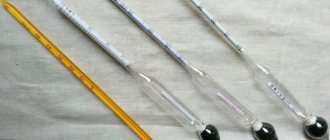Working with an optical tape measure
The operation of such devices is based on the property of reflection of the beam from the object to which the distance is measured. Metal detectors operate using this method. There are two measurement methods:
- There is a principle of operation of laser roulette based on the properties of the pulse. The beam reaches the measurement object, and the built-in counter counts the time it takes to travel this distance and back. This time must be divided by the speed of light, equal to the speed of the beam. The distance is calculated from the table.
- More common and convenient tools work on the sinusoidal law. This means that the processor compares the phase graphs of the beam sent to the object and returned back. This method is called phase.
Basic and additional functions
When purchasing a tool, the future owner has several capabilities that each rangefinder has. Regardless of the model, such devices perform the following calculations:
- Volume, area, diagonal.
- The simplest mathematical operations.
- Angles and dimensions of slopes and inclined surfaces.
- Saving measurement results in memory.
In addition to standard operations, there are additional ones. They depend on the capabilities of the microprocessor and, accordingly, the price. Available for an additional fee:
- Color screen.
- Digital Thermometer.
- Visir.
- Data transfer via Bluetooth.
- Battery remaining charge indicator.
- Calculation of special engineering formulas.
- Device location - tracking.
Operating rules
The main advantage of such a measuring device is ease of use and speed of calculations. It will show the greatest efficiency in conditions of moderate temperatures, dim light and low dust levels. When working in bright light, you will need to wear safety glasses. For accurate measurements, you need to know how a laser tape measure works:
- It is better to take measurements with a firmly fixed device. It is advisable to use a tripod. This will prevent your hands from shaking.
- Turn on the device.
- Use the special func button to fix the start of the countdown.
- Determine in what units the information will be reflected.
- Make sure you make the right choice.
- Avoid getting the beam into your eyes.
An optical rangefinder is a device that requires careful and careful handling. Its service life can be extended. To do this, the following rules are followed:
- Use the device only for the purposes specified in the instructions.
- Observe storage conditions: clean, dry place at moderate humidity and temperature.
- Avoid scratches, impacts, shocks.
- If the device is not being used, it should be in a case.
- Do not open or repair the device yourself.
Advantages and disadvantages of the device
In addition to the noted speed and convenience of measurements, there are also properties that are valued in laser tape measures. With it you can take measurements without outside help: set it in the desired direction and approach the required point with the measuring bar. All additional measurements are made with a few touches of buttons. There is no need to purchase additional devices for computing.
Instructions for using a laser rangefinder
FEATURES OF OPERATING THE DEVICE Your device is a precision laser instrument. Please read the following guidelines for operating the laser rangefinder. • Do not point the device at the sun or any other strong light sources. This may result in measurement errors. • Do not use the rangefinder as a level. • Do not use the device in humid weather, dusty or smoky conditions, or any other unfavorable conditions. If used under such conditions, internal components may be damaged and the instrument's accuracy may be impaired. • When moving the appliance from cold to warm, wait until the appliance reaches ambient temperature. • Measurements through colorless liquids (water) or other translucent materials (glass, plastic, polyethylene) and other materials with low density may not be correct. • Surfaces with anti-reflective coating refract the laser beam and, as a result, measurement errors may occur. • Shiny and bright surroundings combined with a low reflective surface will reduce the measurement range and accuracy. • Do not place the device in water. Wipe off dirt with a damp soft cloth. Do not use aggressive cleaning agents or solutions. Carefully care for optical surfaces. • If the device has been dropped or subjected to shock, its accuracy must be checked before use.
SAFETY RULES Warning; Please read this manual before using the device. The rangefinder has a built-in laser beam. This Class II laser has an output power of 1 milliwatt and a wavelength of 650 nanometers. These lasers are not very harmful to your eyes, but DO NOT LOOK into the beam to avoid temporary blindness. Warning; Laser radiation. Avoid direct laser exposure to your eyes. Do not look at the laser beam at a right angle. Turn on the laser beam only when you are using the device. Do not look at the laser beam through any optical device, as this will increase the harmful effects of the beam on the eyes. Warning; Using the device for purposes not described in this manual is not permitted. Warning; • Do not move or damage the labels on the device. • Avoid direct laser exposure to the eyes. The laser beam may cause temporary vision loss. • Do not install the device in a position where anyone may look into the laser beam, either intentionally or unintentionally. • Do not point the laser beam at polished, reflective surfaces (eg mirror, sheet steel). A polished surface can reflect the beam back. • Do not attempt to repair or disassemble the device. Repairs to this device should only be carried out by an authorized service center. • Do not use the device near flammable substances. • Do not use accessories not designed for this device.
Prohibited; — use outside the specified limits of use; — deactivation of security systems and removal of explanatory and warning labels; — disassembling the device; — change in the design of the device or its modification; — use of accessories not intended for this device; — irresponsible handling of the device on scaffolding, ladders, when measuring near working machines or open parts of machines and installations; — direct pointing of the device at the sun; - deliberate blinding of strangers; — measurement in places of increased danger without proper precautions (for example: measurement on roads, construction sites). Note: Replace the battery when the indicator shows no charge. IX If the battery indicator shows one bar I 3, you will be able to take approximately 100 readings. Remove the battery from the device if you do not use it for a long period of time.
INSTALLING BATTERIES
1. Open the battery compartment cover 2. Insert the battery according to the polarity indicators in the battery compartment. Make sure the battery position matches the polarity! 3. Close the lid.
Notes 1 Replace the battery when the indicator shows no charge 2 If the battery indicator shows one bar, you will be able to take approximately 100 measurements Remove the battery from the device if not using it for a long time
DESCRIPTION Examine your device. Range finder is a precise measuring device : 1. The range finder is used for: - measuring linear distances; — carrying out indirect measurements (function of the Pythagorean theorem); - calculation of area and volume. 2. Easy-to-use backlit screen. 3 Automatically turns on the display backlight 4. Automatic shutdown function. The device turns off
1 Hand strap mounting bracket. 2 Display. 3 Button for measuring / turning on the laser beam / continuous measurement mode. 4 Add/subtract button, turn on/off the sound signal. 5 Button for turning on the mode of measuring areas/volume 6 Button for turning on the mode of “indirect” measurements (Pythagorean theorem function). 7 Reference point/unit switch button. 8 On/off/reset button.
1 Value in memory cell/maximum measurement value. 2 Sign of the value in the memory cell. 3 Value in memory cell/minimum measurement value. 4 Measurement mode. 5 Area and volume measurement mode indicator 6 Measurement values 7 Battery charge level. 8 Degree of value in the device memory. 9 Indicator that the laser beam is on. 10 Measurement reference point. 11 Unit of measurement. 12 Indicator of “indirect” measurement mode
MAIN TECHNICAL SPECIFICATIONS Measuring range: 40 m Measurement error: ±2.0 mm * Minimum unit of measurement: 1 mm Automatic shutdown: laser - 45 sec, instrument -180 sec Laser: 650 nm, class II, power less than 1 mW Optimal operating temperature mode: 0°С…+40°С Storage temperature:-20°С…+60°С Dimensions: 110x43x26 mm Weight: 70 g
Under favorable conditions (good reflective surface, room temperature). Under unfavorable conditions such as bright sunlight, very low surface reflection or large temperature differences, the measurement range may be less than stated and the error may increase to ±0.25 mm/m.
Measurements 1. Turn on the device by pressing the button. After self-diagnosis, the device will display a reference point indicator on the display, and the one-time measurement mode indicator will blink. 2. Press the DIST to turn on the laser. 3. When you press the DIST the device will take a measurement. The measurement results will appear in the bottom line of the display. 4. To take the next measurement, press DIST . The results of the first measurement are moved to the middle line of the display. 5. Press DIST again. The bottom line of the display shows the current measurement value. 6. To delete measurement readings, press 7. The device is turned off by pressing and holding the button for 2 seconds.
Continuous measurement mode (tracking) 1. Turn on the device as described above. 2. Press and hold DIST for 2 seconds. The device will take measurements continuously. 3. To stop the operation of the device, press DIST or the maximum measurement value will be displayed in the top line, the minimum value in the middle line, and the last value in the bottom line. 4. To turn off continuous measurement mode, press
5. Point the laser at the object to measure the second side. 6. Press DIST ; the middle line will display the value of the second measurement, the bottom line will display the measured area. Click to undo the last action. To exit the current measurement mode, press twice
Measuring wall area Using the device, you can calculate the area of walls in a room. 1. Press twice to enable wall area measurement mode; The flashing line on the indicator shows the height of the walls that needs to be measured. 2. Press DIST to turn on the laser beam; The laser indicator will flash. 3. Point the laser at the object you want to measure. 4. Press DIST ; The top line of the screen displays the measured distance (wall height). A line indicating the length of the first wall begins to blink on the indicator. 5. Point the laser at the object to measure the first wall. 6. Press DIST ; the middle line will display the value of the second measurement, the bottom line will display the area of the first wall. A line indicating the length of the second wall begins to blink on the indicator. 7. Press DIST ; the middle line of the display shows the measurement value of the second wall, and the bottom line shows the total area of the two walls. 8. Press DIST if you need to continue measuring wall areas, repeat step. 5-6; the total measured area will be displayed in the bottom line of the display and will be calculated based on the previously measured wall heights (step 4) and sequentially measured wall lengths. Click to undo the last action. To exit the current measurement mode, press twice
Volume measurement 1. Press three times to enter volume measurement mode; The flashing line on the o icon indicates the length to be measured. 2. Press DIST to turn on the laser beam; The laser indicator will flash. 3. Point the laser at the object you want to measure. 4. Press DIST ; The top line of the screen displays the measured distance. The second line on the indicator begins to blink. 5. Point the laser at the object you want to measure. 6. Press DIST in the middle line of the screen the value of the second side will be displayed, in the bottom - the area calculated as a result of the two previous measurements. The third line starts flashing on the indicator. 7. Press DIST ; the third measured value will be displayed in the middle line. The calculated volume will be displayed on the bottom line of the screen. Click to undo the last action. To exit the current measurement mode, press twice
Carrying out “indirect” measurements (measurement using the Pythagorean theorem) Determining distance using two additional measurements
1. Click to enable indirect measurement mode. The flashing line on the icon indicates the first side (hypotenuse) of an equilateral triangle that needs to be measured. 2. Press DIST to turn on the laser beam; The laser indicator will flash. 3. Point the laser at the object. Press DIST to measure the distance to point 1 (see Fig. 1.); The measurement results are displayed on the top line of the screen. The side of the triangle (leg) on the icon begins to flash. 4. Without changing the position of the reference point, point the laser beam at point 2 (see Fig. 1.). Press DIST ; the result of the second measurement is displayed in the middle line of the screen, the value of the calculated third side of the triangle (the distance between points 1 and 2) is displayed in the bottom line.
Click to undo the last action.
To exit the current measurement mode, press twice
Rice. 1
Determining the distance using three additional measurements Using three additional measurements, you can determine the distance between points 1 and 3 (see Fig. 2) and the distance between points 1 and 2 (see Fig. 3) 1. Press DIST twice or thrice to selecting a measurement scheme displayed on the device display. 2. Take three measurements in succession as described above (see section “Determining distance using two additional measurements”). After the last measurement, the calculated value will be displayed in the bottom line.
Click to undo the last action. To exit the current measurement mode, press twice
SELECTION OF A REFERENCE POINT The device can take measurements from two points: - from the rear edge of the device; — from the front edge of the device; Switching reference points is carried out by successively pressing the U . At the same time, the corresponding indicator lights up on the display.
SETTING THE UNIT OF MEASUREMENT In any operating mode of the device, you can change the unit of measurement. Press and hold U ; the device switches to measurement mode in meters/inches/feet.
ADD/SUBTRACT With this function you can add or subtract measured values. 1. Press DIST to turn on the laser beam; The laser indicator will flash. Point the laser at the object you want to measure. 2. Press DIST to take a measurement. The measurement result is shown in the bottom line of the display. 3. Press +/- once to add or twice to subtract, the value of the first measurement moves to the middle line. 4. Press DIST ; The laser indicator will flash. 5. When pressed again, the second measured value is displayed in the bottom line. 6. Press DIST ; the second measured value is moved to the middle adjustment, the calculated sum/difference is displayed in the bottom line. 7. To reset the values, press
TURNING ON/OFF AUDIO SIGNAL To turn on/off the sound signal, press and hold +/-
ERROR SIGNALS These signals may appear on the device screen:
| 301 | Measurement out of range | Maintain the required range |
| 302 | Reflected signal is too weak | Use a reflective plate |
| 303 | Display error | Turn the device off and on |
| 304 | Calculation error using the Pythagorean theorem | Take measurements in the correct sequence |
| 305 | The battery is running low | Replace the battery with a new one |
| 306 | Temperature too low | Place the device in a warm place |
| 307 | Temperature too high | Place the device in a cool place |
| 308 | Ambient lighting is too strong | Choose a place with less bright light to measure |
CARE OF THE DEVICE This device does not require any special operating costs or maintenance. However, in order for the device to remain in good condition for a long time, you need to follow these simple instructions: • Always handle the device with care, as with any optical device. • Protect the device from shock, vibration, extreme heat and extreme cold. • Always store the device indoors. When you are not using the device, store it in a special bag. • Protect the device from exposure to dust and liquids. To clean the device, use only a clean, soft cloth. If necessary, lightly dampen the cloth with pure alcohol or water. • Do not touch the lenses. • Check the battery charge regularly to avoid deterioration of the device's performance. Always remove batteries from the device if you do not intend to use it for a long period of time. • Replace the batteries when the battery indicator lights up on the screen. • Do not disassemble the rangefinder.
DISPOSAL Do not throw measuring instruments into municipal waste! According to the European Directive 2002/96/EC on waste electrical and electronic instruments and appliances and its implementation into national law, end-of-life measuring instruments must be collected separately and sent for environmentally friendly recycling.
Types of rangefinders
Based on the principle of operation, laser rangefinders are divided into phase and pulse.
Phase meters
Phase rangefinders do not have a very long range, but they are much more accurate due to the principle of their operation and are cheaper due to the fact that they do not have an expensive, ultra-precise timer built into them.
The phase rangefinder works at short distances, but has good accuracy and a low price
The operating principle of rangefinders of this type is that a laser wave is sent to an object with one phase, and when reflected, returns with another. Having calculated the phase shift, the device determines the distance to the object. Thanks to this operating principle, phase rangefinder measurements are highly accurate. If it is necessary to work at distances exceeding the emitted wavelength, the device sends a signal several times, changing the modulation frequency. The device's processor then determines the exact distance to the target by solving a system of linear equations.
Pulse meters
A pulse rangefinder consists of a radiation detector and a pulsed laser. It calculates the distance to an object by multiplying the travel time of the beam by the speed of light. Pulse meters operate over much greater distances than phase meters due to the higher power of the emitted pulse. Such rangefinders are often used for military sights.
Comparison of the operating principles of pulse and phase meters
- A phase rangefinder uses a modulated light signal to measure distance, while a pulse rangefinder uses a light pulse.
- Pulse rangefinders measure much longer distances than phase ones, since the power of the pulses they send is much greater.
- The pulse distance measurement method is less accurate than the phase difference method. But thanks to modern signal processing techniques in pulse rangefinders, this difference becomes less significant.
- The size of the reflected laser dot becomes larger with increasing distance. This is true for both measurement principles, although the deviation of the laser from the reflection point is different because the size and shape of the laser spot is different.
- The phase and pulse principles of operation also differ in sensitivity to signal interruption. When operating under the influence of certain external factors (in traffic, in bad weather conditions), a phase rangefinder will perform worse than a pulse rangefinder.
What is a rangefinder
Regardless of the great variety of types and models, a portable rangefinder is always a compact device with an autonomous power source that measures the distance from itself to the nearest point it is aimed at.
According to the principle of operation, all non-contact measuring instruments are divided into 2 groups: Active - determine the distance to a point using a sound, light or laser beam emitted by the device. Having reached the nearest obstacle, photons of light or a sound wave are reflected and sent back to the rangefinder. The sensitive sensor instantly captures the received signal, obtaining the most accurate time in microseconds (µs). Since the speed of sound and light is generally known from school physics lessons, determining distance comes down to a banal division.
For example, light travels 1 cm in 29.2 μs, and the beam we fired returned after 292 μs. Therefore, to get the distance, we divide 292 by 29.2 and get 10 cm, which is further divided in half, since the beam passes the same path twice (from the emitter and to it). As a result of such an elementary formula, the distance displayed on the device display is determined.
Passive - make calculations based on an isosceles triangle, where the required distance is its height (h), and the length of the base is known. This principle with the calculation formula is presented below and underlies optical, monocular, filament and stereoscopic rangefinders. Similar devices are used in geodesy, hunting, sports and tourism, where measurements start from 500 meters and exceed 2 kilometers. In this article, passive rangefinders are presented for review as a large group of measuring devices. Such devices are not used in precision construction work.
Since the topic of the article is devoted to the analysis of simple and compact measuring instruments for construction, we will focus on them. The laser rangefinder is designed for extremely accurate measurements with an error of 1-3 mm, at 5-10 meters (depending on the model). The tool is successfully used in construction, installation and repair.
The operating principle of a laser roulette can be based on a pulse or phase method. The first one calculates the distance based on the time it takes for the pulse to travel from the rangefinder to the surface and back. The phase measurement method is more complex and is based on the difference between emitted and received rays. Such rangefinders determine the distance a little longer than pulse ones, but they provide more accurate readings and are cheaper.
Additional functions
The presence of electronic filling in the device opens up a lot of third-party capabilities that can be implemented without affecting the main function of the instrument. Moreover, manufacturers strive to expand the basic options, linking add-ons with the main task of the user. For example, a multifunctional device can provide the operator with the ability to measure area, angle, volume of a room, etc. In addition, a laser range finder with a level and tape measure is equipped with functions for adding values. There are also built-in calculators for automatic work with calculated data. For the convenience of complex activities, the developers provide the models with charge level indicators and air temperature sensors.
What affects accuracy?
If we compare measurements with a conventional metal tape measure and a laser rangefinder, we can note the following points:
- It is difficult to measure internal dimensions with a tape measure. For example, window and door openings, see Fig. 1. and Fig. 2., the length and width of the premises, and especially their height;
- It is difficult to measure external dimensions with a laser rangefinder (without a target). For example, the length and width of the door leaf, the length of the window sill, see Fig. 3.;
- It is difficult to take measurements with a tape measure, even a long one, if there is a mesh fence or picket fence in the way. A laser rangefinder will do a much better job here.
Fig.1. When measuring openings it is difficult to take a reading using a tape measure
Fig.2. When measuring with a tape measure in a doorway, it is difficult to take readings
Fig.3. It is difficult to measure external dimensions with a laser rangefinder (without a target) - the laser beam slides over the surface, reflecting and scattering many times
What to look for when choosing?
Before you start choosing a laser tape measure, you need to decide on the conditions in which it is intended to be used. So, if for indoor use you can choose absolutely any model of average functionality, then for outdoor use it is recommended to take a device with a sighting device. This is due to the fact that outdoors, even from a distance of 10-15 meters, it is almost impossible to see, much less fix, a given point. Built-in sights, in turn, are optical and digital.
Optical models are an earlier version of the devices and are not so common nowadays. Such samples, as a rule, have a 2-fold magnification, which allows you to quite accurately adjust the direction of the beam and perform measurements according to all the rules. A significant disadvantage of optical sights is the need to use a tripod, since holding the rangefinder suspended and looking through the peephole, it is quite difficult to clearly fix the crosshair of the sight at the desired point.
Therefore, if finances allow, it is better to choose a rangefinder with a digital viewfinder, which is a built-in camera with a zoom that displays the image on the screen. In order to mark a point on a distant surface, you only need to align it with the display crosshair and take a measurement. Digital models are much more convenient than optical ones and have 4x magnification. This allows you to easily take measurements in hard-to-reach and inconvenient places, for example, at floor level: looking through the peephole in such cases is extremely inconvenient, and finding and marking a point on the display screen is not difficult.
The next selection criterion is the measurement range
And if with the maximum value everything is simple and everyone chooses a model in accordance with the nature of the work to be done, then attention is not paid so often to the minimum measurement distance. This approach is fundamentally wrong, since situations often arise when it is necessary to measure a narrow space or determine the size of a structural element
Therefore, it is better to choose a device that can measure distances from 5 cm. To be fair, it is worth noting that most models work precisely in this range, however, there are many devices that measure from 50 cm. At the same time, there is absolutely no difference in price between the first and second, in Therefore, it is better to choose a rangefinder with a wider operating range.
Another important selection criterion is the accuracy of measurements. The bulk of devices in the mid-price category (up to 6,000 rubles) have an error of 1.5 to 3 mm, while for more expensive options this figure barely reaches 1 mm. However, these values are not constant and depend on sunlight, the immobility of the rangefinder during operation and the range of the object. So, as the distance between two points increases, the error will increase, and vice versa.
Also, when choosing a model, you should pay attention to the presence of additional functions. Thus, the tracking option will allow you to continuously measure distances while moving the rangefinder, and then show the results obtained
This option is necessary in cases where it is necessary to measure part of a room or the length of an overall structure. Another useful option is the ability to measure angles. Products with a protractor are necessary when constructing roofs and measuring curved foundations. If you plan to make multiple geometric calculations using formulas for calculating area, angles and volume, then you need to purchase a model with a strong microprocessor and good software.
For work in the field, as well as for street measurements, it is recommended to choose rangefinders with a tripod, while for indoor work, it will be enough to place the device on a table or floor, and the purchase of a tripod will not be required. And final advice: when buying a laser rangefinder, it is better to opt for battery-powered models. This is due to the fact that when purchasing a product with a built-in battery, when its working life is exhausted, it may be difficult to replace it.
What to look for when choosing a laser rangefinder
There are many models of laser rangefinders on the market, and often the consumer can simply get confused by the abundance of offers. Therefore, the consumer, when choosing a laser rangefinder, can be guided by certain criteria, including the following:
- For indoor work, a device that can measure angles and have functions, for example, calculating the perimeter, is sufficient. Tape measures of this class have a small measurement range of approximately 100 meters.
- For work in open spaces, more expensive models are used. They are equipped with a wide range of functions, in particular, they can measure minimum and maximum measurements. In addition, they are equipped with sights and means of connecting to a computer.
- For outdoor work, devices must be used in protected housings and have cases designed for transportation.
- Of course, the cost of the product plays an important role. Thus, devices designed for indoor use are slightly cheaper than those designed for outdoor use.
- Of course, we cannot ignore the question of which company produced the product. Devices produced by Makita, Bosch, Hilti and some others are in stable demand. By the way, when purchasing such a device, it is advisable to check the availability of documents confirming the quality and safety of these devices. The fact is that the popularity of such devices has led to the fact that there are a large number of low-quality devices on the market.
Device
The weight of the device is usually about 200 grams. A laser tape measure is capable of making measurements with small deviations (error). The device can be used both indoors and outdoors. This device can also be used to measure rooms with complex layouts.
Laser rangefinder includes:
- on/off button;
- reflector;
- display;
- tripod;
- sight;
- emitter;
- microprocessor;
- software;
- spirit level;
- glasses.
Now let's take a closer look at the important parts of the device.
- Frame. The material used to make the laser rangefinder housing is a durable eraser. Rubber or latex inserts are also used to prevent damage to the case when the device is dropped. The laser rangefinder uses lenses with an anti-fog effect. The kit includes a cover that protects the device from dust and dirt. A good rangefinder is not afraid of either high humidity or temperature fluctuations. Accordingly, the price of such products is high.
- The emitter is the part of the device from which the laser beam emanates.
- A reflector is an optical filter that receives the returning light beam after reflecting it from an obstacle.
- Microprocessor - converts the light signal into a digital one for processing by a program and displaying data on the screen.
- The software largely depends on the purpose of the laser rangefinder. The functions of a typical household machine include the ability to measure, add and subtract distances. The device can calculate areas, volumes of rooms and heights of buildings.
- Tripod. Used to securely secure the device.
- Visor - with its help you can precisely direct the laser beam at an object. The scope has a 7-10x magnification, which provides good visibility for measurements.
- Spirit level is a level built into the rangefinder. With its help, you can accurately position the device without resorting to additional devices.
Only one person can operate the laser rangefinder.
Laser rangefinders are:
- household;
- professional.
The first are designed to measure distances up to 60 meters, the second - from 60 to 260. The measurement error also differs.
The laser beam has different lengths and powers. Typically, about 650 nm at 1 mW.
Depending on the model, a laser rangefinder can have from 2 to 4 light beam reference points. Usually these are lower or upper panels.
Design and operating principle
Laser range finders are technical devices that use a laser beam to measure the distance and size of objects. Currently, such a device is used in many areas of human activity . This applies not only to construction and renovation work. Similar devices are used in military technology, astronomy and topography, as well as in navigation systems of devices.
The operating principle of an electronic device is to send a laser beam to an object and the ability of the object itself to reflect the sent signal. The design of the roulette has a built-in emitter. He sends out a beam of light. The object reflects the signal, and the reflected signal returns to the receiver.
The tape measure calculates the time from the moment the beam is sent until the receiver receives the returned beam. Based on the time spent and its indicator, the distance and length are calculated.
There are errors in the operation of the device, but they are small and on average range from 1 mm to 2 mm. The error figure depends on the length of the distance being measured. The longer the distance, the larger the error number.
The device itself consists of the following elements and sensors:
- The casing of the tape measure is made of plastic. The design of the device contains anti-shock elements and anti-slip plates for ease of use. The housing completely protects the equipment inside from dust and dirt. The device is light in weight and small in size. It is comfortable to hold in your hand.
- The emitting element is a device that fires a laser beam. Professional equipment has an additional option against fogging of the optical element.
- The receiver is built next to the emitter and receives the reflected beam. This element is also protected from fogging.
- A converter that converts the beam's light signal into a digital value.
- The display provides all the information, including the battery level. It works on the basis of liquid crystals in black and white colors.
- The device is controlled by a unit programmed for correct operation. It is the control unit that performs all the actions: sends a signal to the emitter and receiver, decrypts it and makes calculations. The information is displayed on the display.
Additionally, the electronic rangefinder is equipped with a tripod to ensure accurate measurements without the participation of a human hand. In addition, rangefinders are equipped with bubble levels , and professional equipment has an optical sight in its design. It is impossible for the human eye to measure long distances without its help. The optics recognizes a distance of up to 250 m instantly, and the error figure is minimal.
Tape measure for measuring length - how did such a device appear?
When carrying out a wide variety of construction work, a good specialist simply cannot do without a full set of tools and various devices. However, most of them will be impossible to use if preliminary measurements are not taken, for example: where to drill holes for fastening wires, at what height to place a shelf for books, or at what distance to make a window opening. For this purpose, you need at least metal measuring tapes, but it is better to use something newer.
Given the way people used to measure distance and size, you can imagine that these measurements were somewhat inaccurate. An ancient measure used in Palestine, called the "cubit", was the distance from the tip of the middle finger to the ulna bone. It is easy to understand that everyone's hands are different, so this length of 44.5 cm was very approximate. Why did people use different definitions (length between thumb and index finger, distance from finger to elbow, etc.) if they were so inaccurate? The answer is simple - they did not have a tape measure to measure length. But today we have this valuable device, and every beginning builder can purchase it at any hardware store.
Frame
There is no point in talking about the design, since it is quite famous, and most likely many builders could see it in person.
It is worth noting the professional build quality of the case; all parts are carefully calibrated and matched. There are simply no gaps, defects or backlashes.
On the back of the device there is a battery compartment designed for two AAA batteries, which is clearly closed with a plastic cover.
According to the European classifier, the assembly of the SNDWAY SW-T40 rangefinder corresponds to the dust and moisture protection index - IP54. Therefore, the device is quite well protected. A detailed description of the code can be found in this article. If you are interested in an inexpensive rangefinder with higher protection, then I recommend considering the Mileseey S2 model.
The keyboard consists of 7 keys, which are located at a fairly large distance from each other, so it will also be convenient to work with gloves.
The buttons are pressed clearly with a characteristic click, allowing you to understand that the pressing has been completed, although the material from which the buttons themselves are made seemed soft to me.
There is a possibility that with daily use, within a year the buttons will wear out or be pressed through, this is of course a minus.
The pluses include the presence of a bubble level with a smooth movement of the bubble. At first glance, it’s a trifle, but when using certain indirect calculations you can’t do without it.
The SNDWAY SW-T40 laser rangefinder has a very compact body that fits perfectly in the hand.
To be precise, the dimensions of the tape measure are as follows: length - 112mm, width - 50mm, thickness - 25mm.
Rangefinder design
The operation of laser roulette is based on infrared waves. A wave directed towards some object or obstacle allows you to get an instant result
The design is as follows:
- The plastic casing of the roulette contains: an “on/off” button - turn it on/off;
- monitor;
- emitter;
- reflector;
- processor (microscopic);
- tripod
- glasses (anti-fog lenses)
- software;
- spirit level
For the rangefinder to work, you need 1.5 V, type AA batteries. This economical power source ensures continuous operation for a sufficiently long period.
Main components and characteristics
A laser tape measure, or rangefinder, has the highest accuracy among all household measuring instruments. Its error does not exceed 1-1.5 millimeters per 30 meters, and is used in any closed places. The structure of the roulette and the type of instrument are not very diverse. The main characteristic is the measurement range. For homework, tape measures are produced up to 60 meters distance. Professional rangefinders are designed to range up to 260 meters.
In addition to the distance to the target, an important indicator is the wavelength. Expensive devices are equipped with a laser with this parameter of 630–650 nanometers, which ensures good accuracy of readings. The power of the device is also important, which is about 1 milliwatt. This is an indicator of the red spectrum of radiation, which is dangerous to the retina. This power is mainly found in household models; professional ones use roulettes in the safe green spectrum.
Any optical instrument has the following parts:
Frame
You need to pay special attention to the material of its manufacture before choosing a tape measure. Construction and repair work involves moving in cramped and uncomfortable conditions
Tool falls and impacts occur regularly. This has a bad effect on the meter design. Therefore, it is advisable that it be made of impact-resistant materials. It would be good if the case was rubberized, which would ensure tightness and protection from water and dust. High-quality design makes the product more expensive. The laser beam passes to the measurement object through a peephole - emitter. You should not skimp on its quality. Expensive professional models have a special sighting device - a sighting device. It optically brings the object closer, which improves the quality of measurement. To perform calculations, software is required. With its help, you do not have to manually calculate surface areas and heights of structures. Accordingly, the cost of a device with a large number of determined parameters is higher. For homework, many types of calculations are not very necessary, but for specialists, an expensive and multitasking model will come in handy. The information display device must reflect the maximum number of parameters. Therefore, the larger the roulette display and the number of lines on the screen, the better. A device with four lines is able to show most of the necessary characteristics. To work at night or in rooms without lighting, the display needs to be backlit. For stability and accuracy of measurements, models for professionals are equipped with a tripod. The exact horizontal and vertical position is provided by the level, or spirit level.
Tips for use
Laser roulette is a high-precision device that requires certain rules during operation:
- Do not point the switched-on device at bright light sources, including the sun;
- You cannot use a tape measure as a building level;
- If the device has been moved from a cold room to a heated room, you should wait for some time until its temperature is equal to the ambient temperature;
- Measurements taken through transparent and translucent elastic media may be inaccurate;
- Anti-reflective coatings can also affect the accuracy of measurements;
- It is not allowed to operate the device in water, as well as in smoky, dusty rooms;
- When cleaning, do not use aggressive chemical compounds. Care is carried out using a slightly damp cloth or rag;
- After mechanical impact on the device or its fall, you should check the accuracy of measurements before starting to work with it.
Compliance with these simple rules will significantly extend the life of the device.
Applications and functions of laser rangefinder
Using a laser tape measure, you can calculate the volume, calculate the area of the room, measure complex inaccessible segments, determine the length of the roof slope and its angle of inclination, find the area of the wall with a slope near the ceiling, as well as its diagonal.
Additional features of some modern rangefinders
- Backlight.
- Spirit level or bubble level. This device is most often installed on construction laser tape measures. It will help determine whether the device is level on the surface.
- The viewfinder is a special device that brings the point to which the measurement is being taken closer. The function works similarly to digital zoom on video cameras and is especially relevant for working at long distances.
- Color screen display.
- Air temperature meter. Permissible weather conditions for use of each device are indicated in the instructions. In any case, when working in cold weather, it is necessary to give the device some time to adapt to the ambient temperature.
- Sensor for measuring inclination up to 45o. It is needed to calculate the angle of the roof slope, the slope of the canopy and other similar operations.
- Battery charge level indicator.
- Bluetooth function.
- Tracking is a continuous measurement of distances. When moving the rangefinder, tracking takes measurements not once, but several times with a certain frequency and shows the results obtained. This option is necessary in order to measure the required length of the structure or room.
- Various mathematical functions.
The presence of additional functions in a laser rangefinder helps to make the necessary measurements more accurately and conveniently and greatly facilitates the work. But the price of such devices is much higher.
Working with a laser tape measure
- Install and fix the device at the starting point of measurements.
- Turn on the rangefinder using the special button.
- Select the desired reference point. For convenience, many models have a built-in ability to select a point - from the front of the device body or from the back. This function is needed to determine the distance without taking into account the dimensions of the case. Some devices are also equipped with special brackets that allow you to take measurements in awkward places. The reference point in them can be selected from the edge of the case or from the bracket itself.
- Select the required units of measurement.
- Start measurements by pressing the function button.
- View the result on the device display.
For example, if you need to determine the distance from one wall to another, you need to do the following:
- Install the device on one wall.
- Make sure that the device is fixed flat on the surface and tightly against the wall.
- Set the pressed part of the body as a reference point. This will allow you to take into account the thickness of the tape measure itself in your calculations.
- Enable the start measurement function.
- View the results on the screen.
To obtain more accurate calculations, it is not recommended to hold the device in your hands when taking measurements. It is forbidden to direct the laser beam of the device into the face, because it can burn the retina of the eye.
Video: how to use a laser tape measure
- The laser tape measure should be operated in accordance with the technical instructions.
- Do not allow moisture and dirt to get into the device, as well as overheating and hypothermia of the rangefinder.
- The device must be protected from falls and impacts.
- Repairs to the rangefinder should only be carried out in special workshops.
- It is recommended to store the laser rangefinder in a special case.
Learning to use a laser rangefinder correctly
It's time to figure out how to properly operate a laser distance meter. Each device model comes with instructions that will not only teach you how to use the tool correctly, but will also help you understand the functionality. The general picture of how to use a laser tape measure to determine length is as follows:
- Initially the device turns on. The devices operate from autonomous power sources, which can be ordinary AA batteries or lithium-ion batteries. The rangefinder is turned on by pressing the power button
- After switching on, the display will light up. Using the control buttons, you should set the appropriate measurement mode. On conventional devices you need to select a unit of measurement
- Install the device at the first point from which measurements need to be taken. To do this, all units have a special mark that you need to use when taking measurements.
- As soon as the device is installed at the first point and directed towards the surface, the distance to which needs to be determined, all that remains is to press the button to start the calculations
- Within 2-3 seconds the relevant information will be displayed on the screen
When using the device, one must take into account such a parameter as temperature conditions. For rangefinders used outdoors, this is not as important as for indoor devices. It is recommended to carry out measurements at positive temperatures, as well as with sufficient lighting.
If measurements are taken outdoors, then a number of recommendations must be taken into account:
- It is better to take measurements in cloudy weather, as bright sunlight will distort the measurements.
- It is not recommended to carry out work in heavy fog, dusty air or gas contamination.
- The rangefinder should be secured to a tripod when used in windy conditions. If you hold the device in your hands, even the slightest vibrations will reduce the quality of measurements
When using instruments, it is necessary to take into account that models intended for indoor measurements are not intended for outdoor use, therefore any factors such as rain or dust can lead to accelerated failure of the instrument. Laser rangefinders from 100 to 300 meters can be used to determine distances indoors.
To summarize, it must be said that you can do without a tool such as a laser rangefinder, but the measuring work will take a long time and with great physical effort. Working with devices requires compliance with the following factors:
- The instrument should be stored in a dry and warm place
- If the device uses a lithium-ion battery, you must ensure that it is always charged
- Physical impact on the instrument, that is, hitting it, pressing it down, etc., should not be allowed.
- Do not direct the laser beam into the eyes of humans or animals. This can cause blurred vision and burns.
The slightest damage or impact to the instrument may cause malfunctions and an increase in error. To check the error of the device, it is necessary to measure the measured distance with a mechanical tape measure. By choosing the right laser rangefinder, you can make measuring work easier.
General information about the measuring device
A laser rangefinder, or also called a laser tape measure, has found its active use in construction work, as well as in the field of landscape design, agronomy, topography and other areas. During construction work, the tool is actively used both for exterior and interior finishing.
Having heard about a rangefinder for the first time, the question arises: why and what is it needed for? Its main purpose is to measure distances while being at only one point. Such a tool is intended not only to facilitate the physical work of a person, since it is not at all easy to measure large distances using a tape measure, but also to increase the accuracy of measurements.
In addition to measuring distance, rangefinders (depending on functionality) can perform the following functions:
- calculation of room area;
- determining the volume of the room;
- measurements using the Pythagorean theorem.
The laser rangefinder device includes such key elements as a red or green LED emitter, as well as optical elements of various shapes. The device is a structure reminiscent of a mobile phone, only several times thicker. The devices are equipped with LCD displays that display the measured information. Depending on the model, devices may be equipped with sights, as well as a video camera or other optical devices.
Operating principle of a laser rangefinder
The operating principle of a device such as a laser rangefinder is based on changing the time it takes for the beam to travel to the reflector and back. This principle of operation of the device allows you not only to measure distances, but also to do it with greater accuracy. The electromagnetic wave creates a laser beam that is reflected from the working plane. The beam returns to the receiver, after which the information is processed.
To use the device, it must first be turned on. After this, you need to attach the device to one point of the surface being measured, and then point the beam at the object to which you should measure the distance and press the button. In this simple way, distance is determined using a rangefinder.
The obtained values can be seen on the rangefinder monitor in the units of measurement that were previously set.
Standard rangefinders costing up to 6,000 rubles are capable of measuring distances up to 30 meters. More expensive models allow you to measure distances up to 250-300 meters. When measuring distances on large objects, the use of a special tripod is required, with which you can install the device as accurately as possible. The accuracy of measuring actions is much higher in the dark than during the day, which is due to the low visibility of the laser beam. Expensive models use sights or video cameras, which increase the ability to clearly see the beam.
Features of choice
Before purchasing a device, decide what purposes and types of measurements will need to be made. Will it be household measurements indoors or measurements of large and long distances on the street. Manufacturers produce household and professional appliances. Functionally, such devices may differ.
The measurement range affects the cost of the device, so if the master does not plan to take measurements more than 40 meters, why overpay? For domestic needs, devices are produced with the ability to make measurements from 0.2 to 40 meters.
Determine the accuracy class of the measurements performed. For household values, a measurement error of up to 2 mm is permissible. When performing repair work, this figure is small and uncritical.
Any additional functionality like Bluetooth, calculating diagonals or performing calculations using the Pythagorean theorem will significantly increase the cost of the equipment. In fact, an electronic measuring device is a measuring complex.
How does laser roulette work?
Pulse ranging method
The laser tape measure, which is built on the basis of a pulsed laser and a radiation detector, is called a pulse range finder. This is the simplest type. It works as follows:
- The time counter starts;
- The time it takes for the laser beam to travel to the reflector and back is measured. When the beam returns, the counter is turned off;
- the time reflected on the display is divided by the speed of light;
- the distance to the object is determined.
An echo sounder works on the same principle.
Phase range finder
The operating principle of the phase range finder is based on a sinusoidal law. The phases of the sent and reflected signals are compared. Their difference is the measured distance. These laser rangefinder tape measures are very accurate.
Modes
- standard - used for routine measurements;
- scanning - used if you need to get results from several points;
- rain - used if measurements are taken in adverse weather conditions;
- mirror - if the object has a reflective property.
The rangefinder, as a laser tape measure is also called, measures any distance almost perfectly. This tool can measure horizontal and vertical, open and closed spaces. How else but this device can be used to measure the depth of a well, shaft, or the length of a tunnel.
Principle of operation
Laser measuring instruments use two principles in their work - pulse and phase.
The first rangefinder consists of two components - a laser and a detector. By measuring the time it takes the laser beam to travel along the path from the source to the reflecting object, you can calculate the exact distance between them. These devices are used to work over long distances. The operating technology is as follows: the laser generates a powerful pulse and turns off. This property allows it to be used covertly. This property is the decisive factor determining the use of this device by the military.
The second type, phase, works according to the following principle. The laser turns on for a while and directs the beam to a distant object, it (the beam) has a different simulated frequency and the distance to the object is calculated from the phase change. Phase measuring distances do not have instruments for measuring the reflected signal. These devices are effective at distances of up to 1 kilometer and therefore are used for domestic needs or as sighting devices for small arms.
Scheme of operation of a laser rangefinder
A laser rangefinder, used in everyday life and in construction, is essentially a mixture of a calculator and a tape measure. Meanwhile, such a device has a number of undeniable advantages:
- This device provides the ability to measure linear dimensions (length, height, width), while the built-in calculator will automatically calculate the perimeter. In addition, the calculating device will help determine the volume of the room;
- The rangefinder is equipped with the ability to store received data in internal memory. They can be used to carry out calculations;
- The device allows you to measure distances at remote distances with someone’s help; by the way, measurements can be taken both in indoor and outdoor areas, in different weather conditions.
How to choose a laser rangefinder?
Measuring distances is required in completely different conditions, so the choice of a specific rangefinder laser ruler model will depend on a number of parameters:
- Measuring range
. For the simplest devices it does not exceed 40 m; semi-professional models can measure up to 200 m. - Accuracy
. An inexpensive laser tape measure has an error of no more than 0.3 cm, while more advanced models have an error of no more than 0.1 cm. - Durability
. Due to the fact that the device can be used in bad weather and with a lot of dust, it must be made of impact-resistant plastic and not be afraid of water and dust. - Availability of emphasis
. This may be a retractable or folding pin or bracket. The accessory is needed to measure distance from an inconvenient point, for example, from a corner. - Possibility of carrying out additional calculations
and measuring slopes. - The presence of a bubble level
on the body of the device, which helps to correctly position the device horizontally and vertically. - Tripod mounts
are useful for excavating in open areas. - Battery or battery operation
. A discharged battery must be placed on a charging station for a certain period of time, while batteries can be easily and quickly replaced. - Equipped with additional accessories
, for example, a port for connecting to a computer, a slot for a memory card and a protective case.
Laser rangefinder - functions
In addition to the main function of measuring distance, a laser ruler can have additional capabilities:
- Measurement of area and volume of even complex shaped objects.
- Calculation of sides using the Pythagorean theorem and properties of a trapezoid.
- Setting the reference point. By default, it is calculated from the light beam emitter, but you can also take into account the length of the device itself or the retractable pin.
- Continuous measurement. In this operating mode, the device measures the distance at certain intervals and displays the indicators on the display.
- Determination of maximum and minimum distances. This option is useful when calculating complex quantities.
Case for laser rangefinder
Very often, a construction rangefinder is used in various weather conditions, be it heat, rain or snow, and at a certain height from which it can fall. All this is provided for by responsible manufacturers and they produce devices with increased durability and in a protective case. It can be of two types:
- removable
, then the device must be removed each time to take measurements; - permanent
, which protects the device body even during measuring work.
Laser rangefinder design
Having even a superficial understanding of what a laser rangefinder is, we can confidently conclude that with all the variety of colors and design elements, the device is almost always made in a single concept. Visually and in size, the device is similar to a push-button mobile phone with a laser emitter on the top end (where the flashlight is located on the Nokia 1616). True, unlike the various shapes of telephones, the body of a laser tape measure often has fewer rounded or curved edges. The evenness of the brick and complete perpendicularity of the side edges of the body to the outgoing beam is necessary for ease of measurement.
Budget devices are often equipped with backlit LCD displays, which can display from one to 4 lines of data and various elements (battery indicator or activated function). More expensive devices have LCD displays with a decent range of colors used for interface elements and the viewfinder function with a built-in camera.
The number of buttons on the panel depends on the functionality and ranges from 2 to 10 or more. In most cases, the central button, which stands out from the rest, is responsible for measurement. Next most common is the power off and erase button. On more advanced devices, there are buttons for saving and loading measurements, addition and subtraction, highlighting and control of numerous features, which we discuss below.
